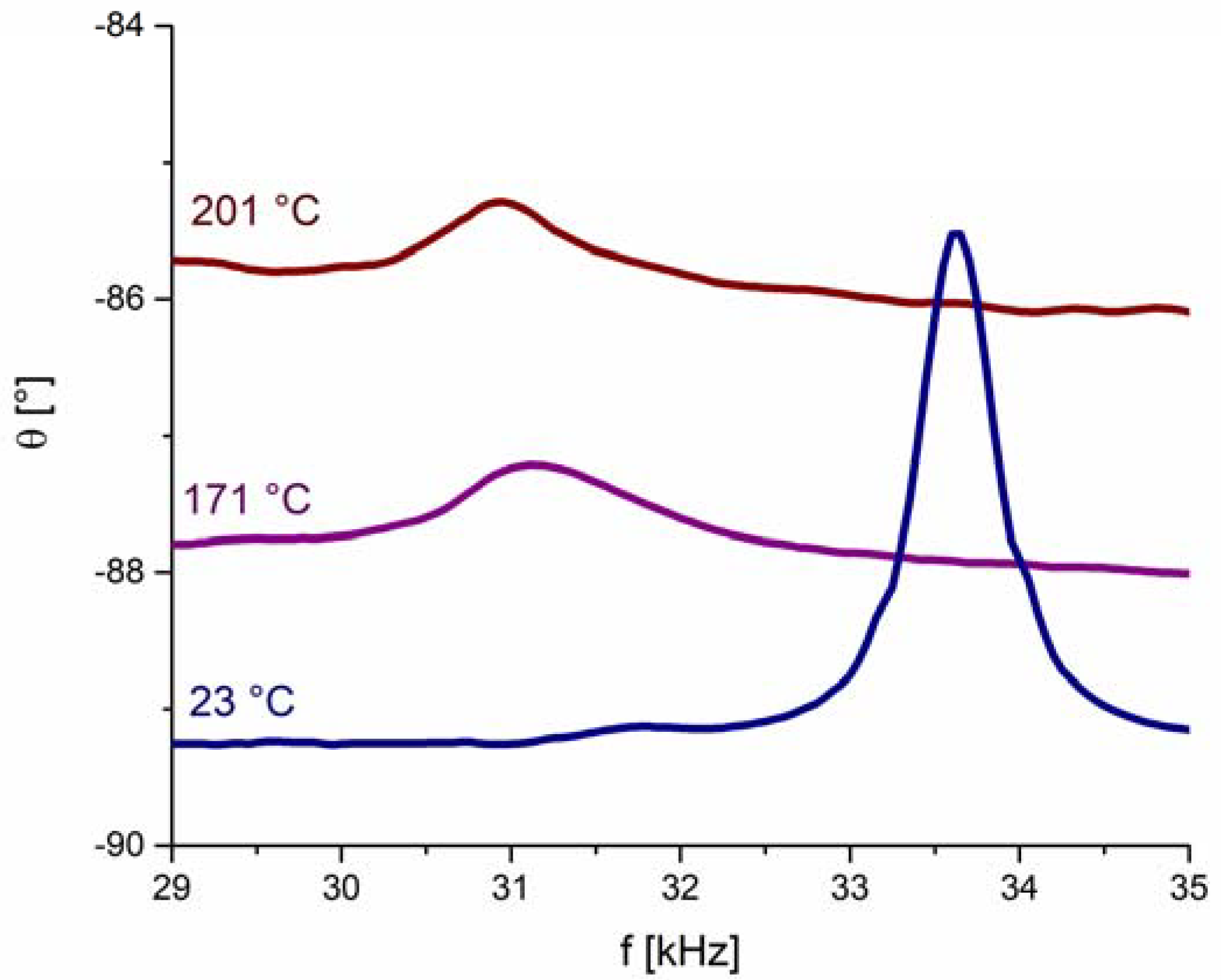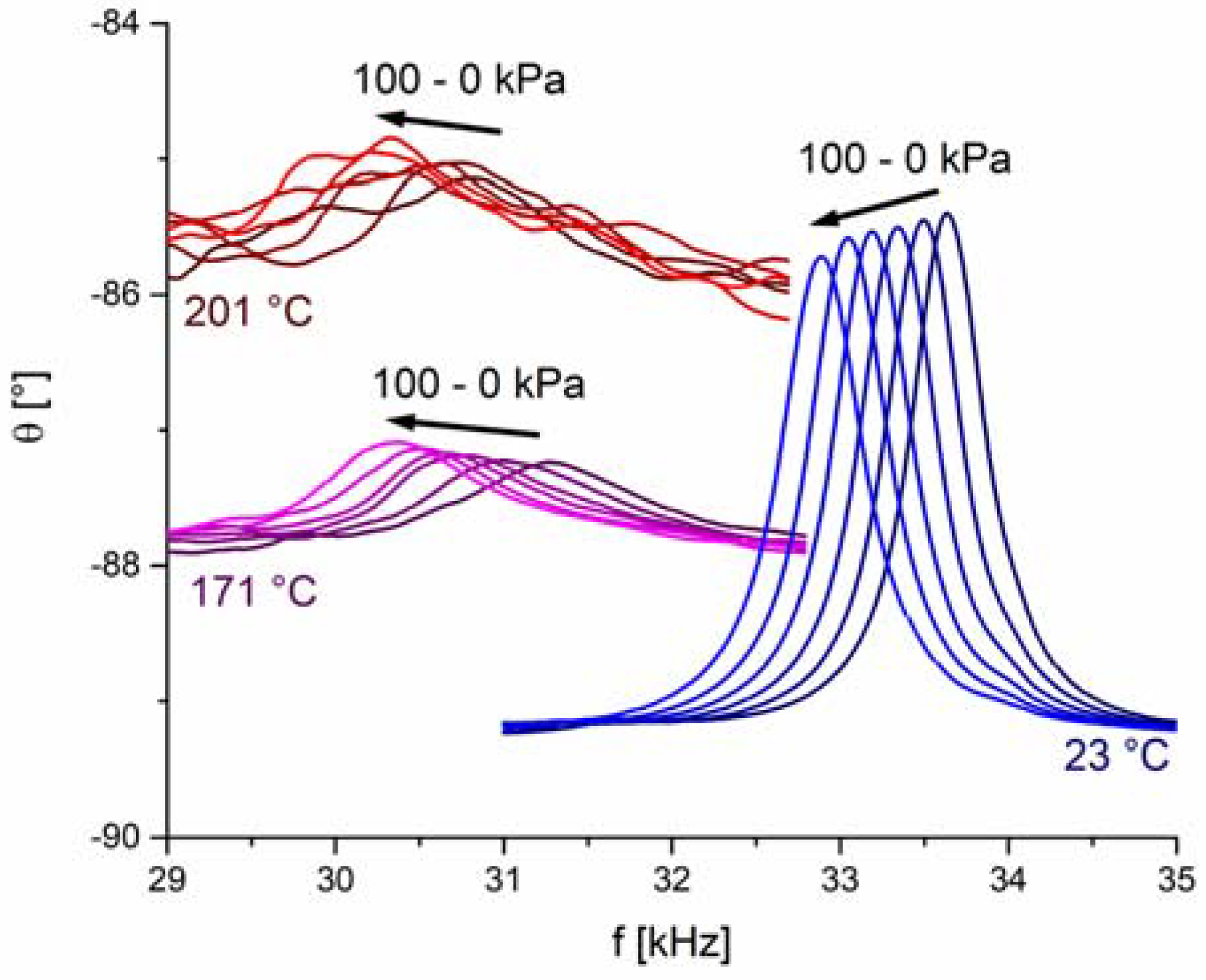Construction and Functionality of a Ceramic Resonant Pressure Sensor for Operation at Elevated Temperatures
Abstract
:1. Introduction
2. Materials and Methods
2.1. Design of the Sensor
2.2. Fabrication
2.3. Measurement Details
3. Results and Discussion
4. Summary and Conclusions
Author Contributions
Funding
Acknowledgments
Conflicts of Interest
Appendix A
| Material | Density (kg/m3) | Young’s Modulus (GPa) | Poisson Ratio |
|---|---|---|---|
| LTCC | 3100 | 110 | 0.17 |
| Adhesive | 1600 | 5.5 | 0.4 |

Appendix B

References
- Eaton, W.P.; Smith, J.H. Micromachined Pressure Sensors: Review and Recent Developments. Smart Mater. Struct. 1997, 6, 530–539. [Google Scholar] [CrossRef]
- Zang, Y.; Zhang, F.; Di, C.; Zhu, D. Advances of Flexible Pressure Sensors Toward Artificial Intelligence and Health Care Applications. Mater. Horiz. 2015, 2, 140–156. [Google Scholar] [CrossRef]
- Belavic, D.; Hrovat, M.; Zarnik, M.S.; Cilensek, J.; Kita, J.; Golonka, L.; Dziedzic, A.; Smetana, W.; Homolka, H.; Reicher, R. Benchmarking Different Substrates for Thick-film Sensors of Mechanical Quantities. In Proceedings of the 15th European Microelectronics and Packaging Conference & Exhibition, Brugge, Belgium, 12–15 June 2005; pp. 216–221. [Google Scholar]
- Belavic, D.; Hrovat, M.; Holc, J.; Zarnik, M.S.; Kosec, M.; Pavlin, M. The application of thick-film technology in C-MEMS. J. Electroceram. 2007, 19, 363–368. [Google Scholar] [CrossRef]
- Zarnik, M.S.; Belavic, D.; Macek, S. The Warm-Up and Offset Stability of a Low-Pressure Piezoresistive Ceramic Pressure Sensor. Sens. Actuators A Phys. 2010, 158, 198–206. [Google Scholar] [CrossRef]
- Zarnik, M.S.; Sedlakova, V.; Belavic, D.; Sikula, J.; Majzner, J.; Sedlak, P. Estimation of the Long-Term Stability of Piezoresistive LTCC Pressure Sensors by Means of Low-Frequency Noise Measurements. Sens. Actuators A Phys. 2013, 199, 334–343. [Google Scholar] [CrossRef]
- Pan, L.; Chortos, A.; Yu, G.; Wang, Y.; Isaacson, S.; Allen, R.; Shi, Y.; Dauskardt, R.; Bao, Z. An Ultra-Sensitive Resistive Pressure Sensor Based on Hollow-Sphere Microstructure Induced Elasticity in Conducting Polymer Film. Nat. Commun. 2014, 5, 1–8. [Google Scholar] [CrossRef] [PubMed]
- Choong, C.-L.; Shim, M.-B.; Lee, B.-S.; Jeon, S.; Ko, D.-S.; Kang, T.-H.; Bae, J.; Lee, S.H.; Byun, K.-E.; Im, J.; et al. Highly Stretchable Resistive Pressure Sensors Using a Conductive Elastomeric Composite on a Micropyramid Array. Adv. Mater. 2014, 26, 3451–3458. [Google Scholar] [CrossRef] [PubMed]
- Belavic, D.; Zarnik, M.S.; Marghescu, C.; Ionescu, C.; Svasta, P.; Hrovat, M.; Macek, S.; Lipuscek, I.; Kocjan, S. Design of a Capacitive LTCC-based Pressure Sensor. In Proceedings of the 15th International Symposium for Design and Technology of Electronics Packages (SIITME), Gyula, Hungary, 17–20 September 2009; pp. 31–36. [Google Scholar]
- Belavic, D.; Zarnik, M.S.; Macek, S.; Jerlah, M.; Hrovat, M.; Pavlin, M. Capacitive Pressure Sensors Realized With LTCC Technology. In Proceedings of the 31st International Spring Seminar on Electronics Technology, Budapest, Hungary, 7–11 May 2008; pp. 269–272. [Google Scholar]
- Mannsfeld, S.C.B.; Tee, B.C.K.; Stoltenberg, R.M.; Chen, C.V.H.-H.; Barman, S.; Muir, B.V.O.; Sokolov, A.N.; Reese, C.; Bao, Z. Highly Sensitive Flexible Pressure Sensors with Microstructured Rubber Dielectric Layers. Nat. Mater. 2010, 9, 859–864. [Google Scholar] [CrossRef] [PubMed]
- Kang, B.S.; Kim, J.; Jang, S.; Ren, F.; Johnson, J.W.; Therrien, R.J.; Rajagopal, P.; Roberts, J.C.; Piner, E.L.; Linthicum, K.J.; et al. Capacitance Pressure Sensor Based on GaN High-Electron-Mobility Transistor-on-Si Membrane. Appl. Phys. Lett. 2005, 86, 253502. [Google Scholar] [CrossRef]
- Ramuz, M.; Tee, B.C.-K.; Tok, J.B.-H.; Bao, Z. Transparent, Optical, Pressure-Sensitive Artificial Skin for Large-Area Stretchable Electronics. Adv. Mater. 2012, 24, 3223–3227. [Google Scholar] [CrossRef] [PubMed]
- Yun, S.; Park, S.; Park, B.; Kim, Y.; Park, S.K.; Nam, S.; Kyung, K.-U. Polymer-Waveguide-Based Flexible Tactile Sensor Array for Dynamic Response. Adv. Mater. 2014, 26, 4474–4480. [Google Scholar] [CrossRef] [PubMed]
- Belavič, D.; Bradeško, A.; Zarnik, M.S.; Rojac, T. Construction of a Piezoelectric-Based Resonance Ceramic Pressure Sensor Designed for High-Temperature Applications. Metrol. Meas. Syst. 2015, 22, 331–340. [Google Scholar] [CrossRef]
- Zarnik, M.S.; Belavič, D.; Maček, S.; Holc, J. Feasibility Study of a Thick-Film PZT Resonant Pressure Sensor Made on a Pre-Fired 3D LTCC Structure. Int. J. Appl. Ceram. Technol. 2009, 6, 9–17. [Google Scholar] [CrossRef]
- Dabrowski, A.P.; Golonka, L.J. High Pressure Sensor with PZT Transducer in LTCC Package. Procedia Eng. 2014, 87, 1099–1102. [Google Scholar] [CrossRef]
- Dabrowski, A.P.; Golonka, L.J. LTCC/PZT Differential Pressure Sensor Utilizing Ultrasonic Wave Resonator. In Proceedings of the 37th International Spring Seminar on Electronics Technology(ISSE), Dresden, Germany, 7–11 May 2014; pp. 395–401. [Google Scholar]
- Birol, H. Fabrication of Low Temperature Co-Fired Ceramic (LTCC)-Based Sensor and Micro-Fluidic Structures, Ph.D. Thesis, École Polytechnique Fédérale de Lausanne (EPFL), Lausanne, Switzerland, 2007. [Google Scholar]
- Rödel, J.; Jo, W.; Seifert, K.T.P.; Anton, E.-M.; Granzow, T.; Damjanovic, D. Perspective on the Development of Lead-free Piezoceramics. J. Am. Ceram. Soc. 2009, 92, 1153–1177. [Google Scholar] [CrossRef]
- Tressler, J.F.; Alkoy, S.; Newnham, R.E. Piezoelectric Sensors and Sensor Materials. J. Electroceram. 1998, 2, 257–272. [Google Scholar] [CrossRef]
- Zhang, S.; Yu, F. Piezoelectric Materials for High Temperature Sensors. J. Am. Ceram. Soc. 2011, 94, 3153–3170. [Google Scholar] [CrossRef]
- Stevenson, T.; Martin, D.G.; Cowin, P.I.; Blumfield, A.; Bell, A.J.; Comyn, T.P.; Weaver, P.M. Piezoelectric Materials for High Temperature Transducers and Actuators. J. Mater. Sci. Mater. Electron. 2015, 26, 9256–9267. [Google Scholar] [CrossRef]
- Palai, R.; Katiyar, R.S.; Schmid, H.; Tissot, P.; Clark, S.J.; Robertson, J.; Redfern, S.A.T.; Catalan, G.; Scott, J.F. β Phase and γ − β Metal-Insulator Transition in Multiferroic BiFeO3. Phys. Rev. B 2008, 77, 14110. [Google Scholar] [CrossRef]
- Catalan, G.; Scott, J.F. Physics and Applications of Bismuth Ferrite. Adv. Mater. 2009, 21, 2463–2485. [Google Scholar] [CrossRef]
- Khomyakova, E.; Pavlic, J.; Makarovic, M.; Ursic, H.; Walker, J.; Rojac, T.; Malic, B.; Bencan, A. Integration of BiFeO3 Thick Films onto Ceramic and Metal Substrates by Screen Printing. J. Eur. Ceram. Soc. 2015, 35, 4163–4171. [Google Scholar] [CrossRef]
- Rojac, T.; Makarovic, M.; Walker, J.; Ursic, H.; Damjanovic, D.; Kos, T. Piezoelectric Response of BiFeO3 Ceramics at Elevated Temperatures. Appl. Phys. Lett. 2016, 109, 42904. [Google Scholar] [CrossRef]
- ANSI/IEEE Std. 176–1987- IEEE Standard on Piezoelectricity; IEEE Society: Washington, DC, USA, 1987. [Google Scholar]
- Defaÿ, E.; Millon, C.; Malhaire, C.; Barbier, D. PZT Thin Films Integration for the Realisation of a High Sensitivity Pressure Microsensor Based on a Vibrating Membrane. Sens. Actuators A Phys. 2002, 99, 64–67. [Google Scholar] [CrossRef]
- Fonseca, M.A.; English, J.M.; von Arx, M.; Allen, M.G. Wireless Micromachined Ceramic Pressure Sensor for High-Temperature Applications. J. Microelectromech. Syst. 2002, 11, 337–343. [Google Scholar] [CrossRef]
- Morten, B.; De Cicco, G.; Prudenziati, M. Resonant Pressure Sensor Based on Piezoelectric Properties of Ferroelectric Thick Films. Sens. Actuators A Phys. 1992, 31, 153–158. [Google Scholar] [CrossRef]
- Gongora-Rubio, M.R.; Espinoza-Vallejos, P.; Sola-Laguna, L.; Santiago-Avilés, J.J. Overview of Low Temperature Co-Fired Ceramics Tape Technology for Meso-System Technology (MsST). Sens. Actuators A Phys. 2001, 89, 222–241. [Google Scholar] [CrossRef]
- Bartsch, H.; Welker, T.; Welker, K.; Witte, H.; Müller, J. LTCC Based Bioreactors for Cell Cultivation. IOP Conf. Ser. Mater. Sci. Eng. 2016, 104, 12001. [Google Scholar] [CrossRef]
- Muralt, P.; Kholkin, A.; Kohli, M.; Maeder, T. Piezoelectric Actuation of PZT Thin-Film Diaphragms at Static and Resonant Conditions. Sens. Actuators A Phys. 1996, 53, 398–404. [Google Scholar] [CrossRef]
- Hong, E.; Trolier-McKinstry, S.; Smith, R.; Krishnaswamy, S.V.; Freidhoff, C.B. Vibration of Micromachined Circular Piezoelectric Diaphragms. IEEE Trans. Ultrason. Ferroelectr. Freq. Control 2006, 53, 697–706. [Google Scholar] [CrossRef] [PubMed]
- Epoxy Technology. EPO-TEK® EE129-4; Epoxy Technology: Billerica, MA, USA, 2012; Available online: https://www.laddresearch.com/lanotattachments/download/file/id/15/store/1/lee129-4.pdf (accessed on 25 April 2018).
- Efunda Piezo Data: PZT-5H. Available online: http://www.efunda.com/materials/piezo/material_data/matdata_output.cfm?Material_ID=PZT-5H (accessed on 25 April 2018).
- Jonscher, A.K. Dielectric Relaxation in Solids; Chelsea Dielectrics Press: London, UK, 1983; ISBN 0950871109 9780950871103. [Google Scholar]







| Parts of a Sensor | Dimensions (mm) |
|---|---|
| ddiapragm | 16.0 |
| dpiezo | 4.93 |
| hdiapragm | 0.20 |
| hpiezo | 0.20 |
| T (°C) | R2 | S (Hz/kPa) |
|---|---|---|
| 23 | 0.999 | −7.4 |
| 171 | 0.961 | −8.7 |
© 2018 by the authors. Licensee MDPI, Basel, Switzerland. This article is an open access article distributed under the terms and conditions of the Creative Commons Attribution (CC BY) license (http://creativecommons.org/licenses/by/4.0/).
Share and Cite
Sadl, M.; Bradesko, A.; Belavic, D.; Bencan, A.; Malic, B.; Rojac, T. Construction and Functionality of a Ceramic Resonant Pressure Sensor for Operation at Elevated Temperatures. Sensors 2018, 18, 1423. https://doi.org/10.3390/s18051423
Sadl M, Bradesko A, Belavic D, Bencan A, Malic B, Rojac T. Construction and Functionality of a Ceramic Resonant Pressure Sensor for Operation at Elevated Temperatures. Sensors. 2018; 18(5):1423. https://doi.org/10.3390/s18051423
Chicago/Turabian StyleSadl, Matej, Andraz Bradesko, Darko Belavic, Andreja Bencan, Barbara Malic, and Tadej Rojac. 2018. "Construction and Functionality of a Ceramic Resonant Pressure Sensor for Operation at Elevated Temperatures" Sensors 18, no. 5: 1423. https://doi.org/10.3390/s18051423





